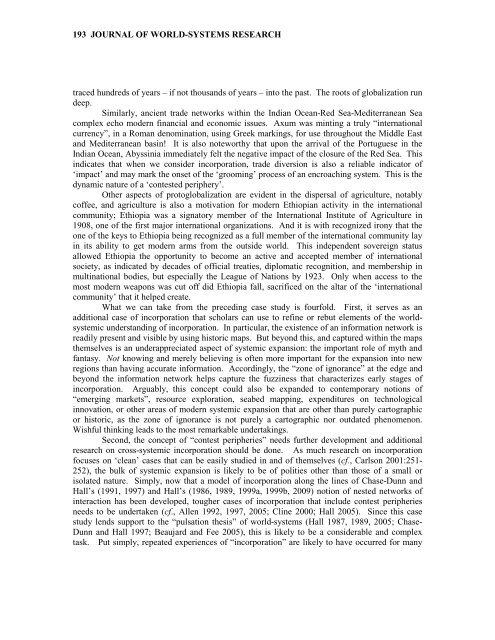Entire Volume 17 issue 1 - Journal of World-Systems Research ...
Entire Volume 17 issue 1 - Journal of World-Systems Research ...
Entire Volume 17 issue 1 - Journal of World-Systems Research ...
Create successful ePaper yourself
Turn your PDF publications into a flip-book with our unique Google optimized e-Paper software.
193 JOURNAL OF WORLD-SYSTEMS RESEARCH<br />
traced hundreds <strong>of</strong> years – if not thousands <strong>of</strong> years – into the past. The roots <strong>of</strong> globalization run<br />
deep.<br />
Similarly, ancient trade networks within the Indian Ocean-Red Sea-Mediterranean Sea<br />
complex echo modern financial and economic <strong>issue</strong>s. Axum was minting a truly “international<br />
currency”, in a Roman denomination, using Greek markings, for use throughout the Middle East<br />
and Mediterranean basin! It is also noteworthy that upon the arrival <strong>of</strong> the Portuguese in the<br />
Indian Ocean, Abyssinia immediately felt the negative impact <strong>of</strong> the closure <strong>of</strong> the Red Sea. This<br />
indicates that when we consider incorporation, trade diversion is also a reliable indicator <strong>of</strong><br />
‘impact’ and may mark the onset <strong>of</strong> the ‘grooming’ process <strong>of</strong> an encroaching system. This is the<br />
dynamic nature <strong>of</strong> a ‘contested periphery’.<br />
Other aspects <strong>of</strong> protoglobalization are evident in the dispersal <strong>of</strong> agriculture, notably<br />
c<strong>of</strong>fee, and agriculture is also a motivation for modern Ethiopian activity in the international<br />
community; Ethiopia was a signatory member <strong>of</strong> the International Institute <strong>of</strong> Agriculture in<br />
1908, one <strong>of</strong> the first major international organizations. And it is with recognized irony that the<br />
one <strong>of</strong> the keys to Ethiopia being recognized as a full member <strong>of</strong> the international community lay<br />
in its ability to get modern arms from the outside world. This independent sovereign status<br />
allowed Ethiopia the opportunity to become an active and accepted member <strong>of</strong> international<br />
society, as indicated by decades <strong>of</strong> <strong>of</strong>ficial treaties, diplomatic recognition, and membership in<br />
multinational bodies, but especially the League <strong>of</strong> Nations by 1923. Only when access to the<br />
most modern weapons was cut <strong>of</strong>f did Ethiopia fall, sacrificed on the altar <strong>of</strong> the ‘international<br />
community’ that it helped create.<br />
What we can take from the preceding case study is fourfold. First, it serves as an<br />
additional case <strong>of</strong> incorporation that scholars can use to refine or rebut elements <strong>of</strong> the worldsystemic<br />
understanding <strong>of</strong> incorporation. In particular, the existence <strong>of</strong> an information network is<br />
readily present and visible by using historic maps. But beyond this, and captured within the maps<br />
themselves is an underappreciated aspect <strong>of</strong> systemic expansion: the important role <strong>of</strong> myth and<br />
fantasy. Not knowing and merely believing is <strong>of</strong>ten more important for the expansion into new<br />
regions than having accurate information. Accordingly, the “zone <strong>of</strong> ignorance” at the edge and<br />
beyond the information network helps capture the fuzziness that characterizes early stages <strong>of</strong><br />
incorporation. Arguably, this concept could also be expanded to contemporary notions <strong>of</strong><br />
“emerging markets”, resource exploration, seabed mapping, expenditures on technological<br />
innovation, or other areas <strong>of</strong> modern systemic expansion that are other than purely cartographic<br />
or historic, as the zone <strong>of</strong> ignorance is not purely a cartographic nor outdated phenomenon.<br />
Wishful thinking leads to the most remarkable undertakings.<br />
Second, the concept <strong>of</strong> “contest peripheries” needs further development and additional<br />
research on cross-systemic incorporation should be done. As much research on incorporation<br />
focuses on ‘clean’ cases that can be easily studied in and <strong>of</strong> themselves (cf., Carlson 2001:251-<br />
252), the bulk <strong>of</strong> systemic expansion is likely to be <strong>of</strong> polities other than those <strong>of</strong> a small or<br />
isolated nature. Simply, now that a model <strong>of</strong> incorporation along the lines <strong>of</strong> Chase-Dunn and<br />
Hall’s (1991, 1997) and Hall’s (1986, 1989, 1999a, 1999b, 2009) notion <strong>of</strong> nested networks <strong>of</strong><br />
interaction has been developed, tougher cases <strong>of</strong> incorporation that include contest peripheries<br />
needs to be undertaken (cf., Allen 1992, 1997, 2005; Cline 2000; Hall 2005). Since this case<br />
study lends support to the “pulsation thesis” <strong>of</strong> world-systems (Hall 1987, 1989, 2005; Chase-<br />
Dunn and Hall 1997; Beaujard and Fee 2005), this is likely to be a considerable and complex<br />
task. Put simply, repeated experiences <strong>of</strong> “incorporation” are likely to have occurred for many





